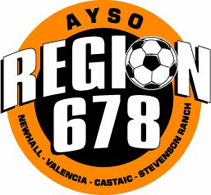Ask the Ref was created to help coaches, referees, players, parents, and spectators get answers to questions about refereeing from the Region 678 Referee Council.
Use the form below to submit your question(s) about referee calls, or interpretations of the Laws of the Game (LOTG). In addition, your questions may be about Region 678 referee policies, such as whether or not slide tackles are allowed (Yes, they are, provided they are done correctly), or about how many quarters a player may play in goal in a 10U game (2). While all questions and answers will be treated confidentially, those of general interest will be posted below for others to benefit from, without the submitter's name.
Ask the Ref
Questions and Answers
Q: We were told there is a new handball rule. Something involving a below the knee standard. Can you explain the current handball rule for U14?
A:
Yes, the law concerning Handball have been pretty significantly refined but there is nothing that refers to a 'below the knee' standard. There is however an 'above the shoulder' standard whereby if the ball should come in contact with the arm from just below the shoulder to the hand while raised above shoulder height, that would be called a Handball.
The refinements on Handball are the most lengthy and in-depth and they are separating what I like to call handball and ballhand. In short, if the hand/arm is in a 'natural position' and the ball coming at them doesn't give them adequate time to move their hand/arm, then this wouldn't be seen as a handball as the hand/arm wasn't deliberately used to control the ball (the ball went to the hand, rather than the hand went to the ball...hence my term 'ballhand'). Also, using the hand/arm to protect one's body parts from a shot too fast to avoid IS a natural position and not seen as a handball. Of course, if the player was protecting themselves but ALSO deliberately directed or attempted to direct the ball then this WOULD be a handball. As with most all calls, the determination of 'was it deliberate or not' is in the judgment of the Referee. Regarding the above-the-shoulder standard mentioned above, aside from the keeper arms held above shoulder height is not recognized as a 'natural position'. Some might argue that their arms thrown in the air helps them to jump, but the arms used in this manner are not required to jump...the legs are doing the work of jumping.
The definition of an 'unnatural position' for the hand/arms relates, in general, to an attempt to make the body bigger when attempting to block the ball. Basically, any attempt to deliberately control the ball with the hand/arm is seen as a handball. This includes some slide tackles if the arm is outstretched in a way to make the body bigger while attempting to block a ball (conversely, a slide tackle or a fall to the ground where the arm is used to protect the body from harm is NOT seen as a handball, but protection as described above). You may see some players attempt to circumvent this by tucking their arm close to their body to appear in a natural position, but then lead the block with their arm when they would have had time to move it...this, again, is attempting to control the ball and seen as a handball. They also may tuck their arms in but discreetly flip their hand out to control the ball...again, this is handball.
You can see, this is one of the most complex laws (along with Off Side) as there are many circumstances to consider. In a nutshell, if the player made an attempt to control the ball in any way with their hand/arm (including leaving them in place when they appeared to have enough time to move them), handball. If they had no time to react and the ball hit the arm/hand (below shoulder height, in a natural position) then ballhand (or no handball). In short, did the hand/arm contact the ball or did the ball contact the hand/arm.
Here are some resources to study the 2019 changes including the handball refinements:
Summary: http://theifab.com/backend/library/doc/summary-of-main-law-changes-2019-20
More complete language: http://theifab.com/backend/library/doc/changes-to-the-laws-and-clarifications-201920
Goal keeper change at kicks from the mark
Q: In the playoffs, U12 division, should it come to goal kicks as a tiebreaker, does the player who played goalie the last period have to be the goalie, or can any player who was on the field play goalie? (I hope the question is clear.)
A: Only players that are on the field of play as players may participate in kicks from the mark (goal kicks). As with regular play, you may substitute the goal keeper with another player that will be participating in the kicks from the mark. This is for all levels of play.
How many players can be in the goal area or penalty area during a team's goal kick?
Q: During a goal kick, if the team taking the kick uses someone other than goalie to make kick, how many other players from the kicking team can be in in the peanlty area and or goal area? Is there a limit? Or can the kicking team have as many players as they want in the penalty and goal area? Thank you for your reply.
A: During a team's goal kick, there is no limit to the number of defenders that can be placed inside the goal area or penalty area. However, The Laws Of The Game stat that "opponents remain outside the penalty area until the ball is in play. Also: the ball is in play when it is kicked directly beyond the penalty area.
Q: What is the rule regarding switching goalkeepers during a quarter in a U10 game. Not at the quarter break, but at some point during the quarter.. If you switch keepers mid quarter, does that count as the 1 quarter in goal for each player?
A: Great questions! Goalkeepers can be switched during the game between the "quarters". There are a couple of issues here and proper procedure must be followed.
- The referee must be informed that the goalkeeper needs to be switched PRIOR to the change of goalkeeper. Switching the goalkeeper without notifying the Center Referee prior to the change is a cautionable offense to both players for unsporting behavior (Cautionable offense = yellow card: although, at U10 we tell the coach the players are being cautioned. We don't show the card).
- The new goalkeeper must be distinguished from other players. This means that he/she must have a different jersey than the other players which is a different color than the other players on the field. Wearing a pinnie overlay is acceptable as long as the color is different than both teams and the referee gives it his/her okay.
- The goalkeeper being replaced must be in the same jersey as his/her team, therefore he/she no longer is wearing the goalkeeper jersey.
- The referee must be informed PRIOR to switching back to their original positions. Switching the goalkeeper without notifying the Center Referee prior to the change is a cautionable offense to both players for unsporting behavior (Cautionable offense = yellow card: although, at U10 we tell the coach the players are being cautioned. We don't show the card).
- During a penalty kick, he may want a "better" goalkeeper during the kick.
- The goalkeeper may be injured.
- During a corner kick, he might want a temporary switch.
- The goalkeeper might be having equipment problems.
"Goalkeepers restrictions – Applies to the U10 & U12 division. If a player participates in three quarters of the match, the player must play two quarters in a field position (other than goalkeeper), meaning they can only play one quarter as goalkeeper. If a player participates in four quarters of the match, the player may play a maximum of two quarters per match as goalkeeper. This requirement is eliminated during regional playoffs."
Therefore, if a player plays two "quarters" as a goalkeeper, he must play two "quarters" on the field. Now, onto the next question and a short answer . . . If you switch keepers mid-quarter, does that count as the 1 quarter in goal for each player? Think of this scenario: if a player is injured and is replaced with another player, who gets credit for the "quarter"? It is the player who started the "quarter" even if he/she only played two minutes! So the answer is no, only the goalkeeper who started in goal will get credit for having played the quarter in goal. Remember, the rules are written to give the children the fairest and most fun game they can have. If someone is trying to gain an advantage by using trickery or trying to manipulate the system, that person is being unsportsmanlike and is jeopardizing his/her team. As a referee, you make note of what has happened on the card. The referee's duty is to control the match and report the information.Q: Do all referees need to be re-certified for Safe Haven each year? Will there be a Referee Refresher course for 2007?
A: Safe Haven only needs to be taken once. It is important that you retain the date that you completed the course and the course number for your records. A second referee refresher course will be conducted within a few weeks. Please check the region's calendar of event for the date and time.


